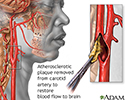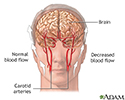Transient ischemic attack
Mini stroke; TIA; Little stroke; Cerebrovascular disease - TIA; Carotid artery - TIA
A transient ischemic attack occurs when blood flow to a part of the brain stops for a brief time. A person will have stroke-like symptoms for up to 24 hours. In most cases, the symptoms last for 1 to 2 hours.
A transient ischemic attack (TIA) is felt to be a warning sign that a true stroke may happen in the future if something is not done to prevent it.
Causes
A TIA is different than a stroke. After a TIA, the blockage breaks up quickly and dissolves. A TIA does not cause brain tissue to die.
The loss of blood flow to an area of the brain can be caused by:
- A blood clot in an artery of the brain
- A blood clot that travels to the brain from somewhere else in the body (for example, from the heart)
- An injury to blood vessels
- Narrowing of a blood vessel in the brain or leading to the brain
High blood pressure is the main risk for TIAs and stroke. Other major risk factors are:
High blood pressure
Blood pressure is a measurement of the force exerted against the walls of your arteries as your heart pumps blood to your body. Hypertension is the ...

Risk factors
A risk factor is something that increases your chance of getting a disease or health problem. Some risk factors for stroke you cannot change. Some ...
-
Irregular heartbeat called
atrial fibrillation
Atrial fibrillation
Atrial fibrillation or flutter is a common type of abnormal heartbeat. The heart rhythm is fast and most often irregular.
 ImageRead Article Now Book Mark Article
ImageRead Article Now Book Mark Article -
Diabetes
Diabetes
Diabetes is a chronic disease in which the body cannot regulate the amount of sugar in the blood.
 ImageRead Article Now Book Mark Article
ImageRead Article Now Book Mark Article - Family history of stroke
-
High cholesterol
High cholesterol
Cholesterol is a fat (also called a lipid) that your body needs to work properly. Too much bad cholesterol can increase your chance of getting heart...
 ImageRead Article Now Book Mark Article
ImageRead Article Now Book Mark Article - Increasing age, especially after age 55
- Ethnicity (African Americans are more likely to die of stroke)
- Smoking
People who have heart disease or poor blood flow in their legs caused by narrowed arteries are also more likely to have a TIA or stroke.
Poor blood flow in their legs
Peripheral artery disease (PAD) is a condition of the blood vessels that supply the legs and feet. It leads to narrowing and hardening of the arteri...

Symptoms
Symptoms begin suddenly, last a short time (from a few minutes to 1 to 2 hours), and go away. They may occur again at a later time.
The symptoms of TIA are the same as the symptoms of a stroke, and include:
- Change in alertness (including sleepiness or unconsciousness)
- Changes in the senses (such as hearing, vision, taste, and touch)
- Mental changes (such as confusion, memory loss, difficulty writing or reading, trouble speaking or understanding others)
- Muscle problems (such as weakness, trouble swallowing, trouble walking)
- Dizziness or loss of balance and coordination
- Lack of control over the bladder or bowels
- Nerve problems (such as numbness or tingling on one side of the body)
Exams and Tests
Often, the symptoms and signs of a TIA will have gone away by the time you get to the hospital. A TIA diagnosis may be made based on your medical history alone.
The health care provider will do a complete physical exam to check for heart and blood vessel problems. You will also be checked for nerve and muscle problems.
The doctor will use a stethoscope to listen to your heart and arteries. An abnormal sound called a bruit may be heard when listening to the carotid artery in the neck or other artery. A bruit is caused by irregular blood flow.
Tests will be done to rule out a stroke or other disorders that may cause the symptoms:
-
You will likely have a
head CT scan
or
brain MRI
. A stroke may show changes on these tests, but TIAs will not.
Head CT scan
A head computed tomography (CT) scan uses many x-rays to create pictures of the head, including the skull, brain, eye sockets, and sinuses.
 ImageRead Article Now Book Mark Article
ImageRead Article Now Book Mark ArticleBrain MRI
A head MRI (magnetic resonance imaging) is an imaging test that uses powerful magnets and radio waves to create pictures of the brain and surrounding...
 ImageRead Article Now Book Mark Article
ImageRead Article Now Book Mark Article -
You may have an
angiogram
, CT angiogram, or MR angiogram to see which blood vessel is blocked or bleeding.
Angiogram
An arteriogram is an imaging test that uses x-rays and a special dye to see inside the arteries. It can be used to view arteries in the heart, brain...
 ImageRead Article Now Book Mark Article
ImageRead Article Now Book Mark Article -
You may have an
echocardiogram
if your doctor thinks you may have a blood clot from the heart.
Echocardiogram
An echocardiogram is a test that uses sound waves to create pictures of the heart. The picture and information it produces is more detailed than a s...
 ImageRead Article Now Book Mark Article
ImageRead Article Now Book Mark Article -
Carotid duplex
(ultrasound) can show if the carotid arteries in your neck have narrowed.
Carotid duplex
Carotid duplex is an ultrasound test that shows how well blood is flowing through the carotid arteries. The carotid arteries are located in the neck...
 ImageRead Article Now Book Mark Article
ImageRead Article Now Book Mark Article -
You may have an electrocardiogram (
ECG
) and
heart rhythm monitoring
tests to check for an irregular heartbeat.
ECG
An electrocardiogram (ECG) is a test that records the electrical activity of the heart.
 ImageRead Article Now Book Mark Article
ImageRead Article Now Book Mark ArticleHeart rhythm monitoring
A Holter monitor is a machine that continuously records the heart's rhythms. The monitor is worn for 24 to 48 hours during normal activity.
 ImageRead Article Now Book Mark Article
ImageRead Article Now Book Mark Article
Your doctor may do other tests to check for high blood pressure, heart disease, diabetes, high cholesterol, and other causes of, and risk factors for TIAs or stroke.
Treatment
If you have had a TIA within the last 48 hours, you will likely be admitted to the hospital so that doctors can search for the cause and observe you.
High blood pressure, heart disease, diabetes, high cholesterol, and blood disorders will be treated as needed. You will be encouraged to make lifestyle changes to reduce your risk of further symptoms. Changes include quitting smoking, exercising more, and eating healthier foods.
You may receive blood thinners, such as aspirin or Coumadin, to reduce blood clotting. Some people who have blocked neck arteries may need surgery ( carotid endarterectomy ). If you have an irregular heartbeat (atrial fibrillation), you will be treated to avoid future complications.
Aspirin
Blood thinners - aspirin; Antiplatelet therapy - aspirin

Carotid endarterectomy
Carotid artery surgery is a procedure to restore proper blood flow to the brain. The carotid artery brings needed blood to your brain and face. You ...

Outlook (Prognosis)
TIAs do not cause lasting damage to the brain.
But, TIAs are a warning sign that you may have a true stroke in the coming days or months. More than 10% of people who have a TIA will have a stroke within 3 months. Half of these strokes happen during the 48 hours after a TIA. The stroke may occur that same day or at a later time. Some people have only a single TIA, and others have more than one TIA.
You can reduce your chances of a future stroke by following up with your provider to manage your risk factors.
When to Contact a Medical Professional
A TIA is a medical emergency. Call 911 or another local emergency number right away. DO NOT ignore symptoms just because they go away. They may be a warning of a future stroke.
Prevention
Follow your provider's instructions on how to prevent TIAs and strokes. You will likely be told to make lifestyle changes and take medicines to treat high blood pressure or high cholesterol.
References
Biller J, Ruland S, Schneck MJ. Ischemic cerebrovascular disease. In Daroff RB, Jankovic J, Mazziotta JC, Pomeroy SL, eds. Bradley's Neurology in Clinical Practice. Philadelphia, PA: Elsevier; 2016:chap 65.
James PA, Oparil S, Carter BL, et al. 2014 evidence-based guideline for the management of high blood pressure in adults: report from the panel members appointed to the Eighth Joint National Committee (JNC 8). JAMA . 2014;311(5):507-520. PMID: 24352797 www.ncbi.nlm.nih.gov/pubmed/24352797 .
January CT, Wann LS, Alpert JS, et al. 2014 AHA/ACC/HRS guideline for the management of patients with atrial fibrillation: a report of the American College of Cardiology/American Heart Association Task Force on practice guidelines and the Heart Rhythm Society. Circulation . 2014;130(23):2071-2104. PMID: 24682348 www.ncbi.nlm.nih.gov/pubmed/24682348 .
Keman WN, Ovbiagele B, Black HR, et al. Guidelines for the prevention of stroke in patients with stroke and transient ischemic attack: a guideline for healthcare professionals from the American Heart Association/American Stroke Association. Stroke . 2014;45(7):2160-2236. PMID: 24788967 www.ncbi.nlm.nih.gov/pubmed/24788967 .
Ledyard HK. Transient ischemic attack and acute ischemic attack. In: Adams JG, ed. Emergency Medicine: Clinical Essentials . 2nd ed. Philadelphia, PA: Elsevier Saunders; 2013:chap 100.
Meschia JF, Bushnell C, Boden-Albala B, et al. Guidelines for the primary prevention of stroke: a statement for healthcare professionals from the American Heart Association/American Stroke Association. Stroke . 2014;45(12):3754-3832. PMID: 25355838 www.ncbi.nlm.nih.gov/pubmed/25355838 .
-
Endarterectomy - illustration
Endarterectomy is a surgical procedure removing plaque material from the lining of an artery.
Endarterectomy
illustration
-
Transient Ischemic attack (TIA) - illustration
A transient ischemic attack (TIA) is caused by a temporary state of reduced blood flow in a portion of the brain. This is most frequently caused by tiny blood clots that temporarily occlude a portion of the brain. A primary blood supply to the brain is through two arteries in the neck (the carotid arteries) that branch off within the brain to multiple arteries that supply specific areas of the brain. During a TIA, the temporary disturbance of blood supply to an area of the brain results in a sudden, brief decrease in brain function.
Transient Ischemic attack (TIA)
illustration
-
Endarterectomy - illustration
Endarterectomy is a surgical procedure removing plaque material from the lining of an artery.
Endarterectomy
illustration
-
Transient Ischemic attack (TIA) - illustration
A transient ischemic attack (TIA) is caused by a temporary state of reduced blood flow in a portion of the brain. This is most frequently caused by tiny blood clots that temporarily occlude a portion of the brain. A primary blood supply to the brain is through two arteries in the neck (the carotid arteries) that branch off within the brain to multiple arteries that supply specific areas of the brain. During a TIA, the temporary disturbance of blood supply to an area of the brain results in a sudden, brief decrease in brain function.
Transient Ischemic attack (TIA)
illustration
-
Transient ischemic attacks
(Alt. Medicine)
-
Stroke
(In-Depth)
-
Heart attack and acute coronary syndrome
(In-Depth)
Review Date: 6/1/2015
Reviewed By: Daniel Kantor, MD, Kantor Neurology, Coconut Creek, FL and Immediate Past President of the Florida Society of Neurology (FSN), Gainesville, FL. Review provided by VeriMed Healthcare Network. Internal review and update on 07/24/2016 by David Zieve, MD, MHA, Isla Ogilvie, PhD, and the A.D.A.M. Editorial team.


